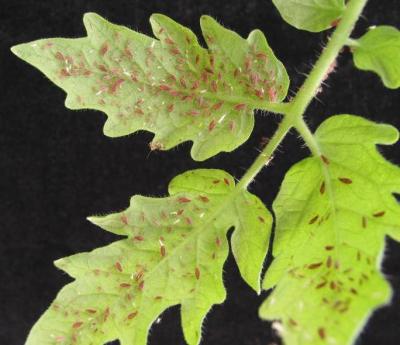The betrayal of the aphids

This photo shows aphids feeding on leaves. Credit: Scott Edwards, UC Riverside
Aphids are devastating insect pests and cause great losses to agriculture worldwide. These sap-feeding plant pests harbor in their body cavity bacteria, which are essential for the aphids' fecundity and survival. Buchnera, the bacterium, benefits also because it cannot grow outside the aphid.
This mutually beneficial relationship is sabotaged, however, by the bacterium which proceeds to betray the aphid, a research team led by scientists at the University of California, Riverside has found.
“Although this betrayal is unintentional, it nevertheless alerts the plant about the aphid's presence and the aphids are unable to reproduce in large numbers,” said Isgouhi Kaloshian, a professor of nematology, who led the research project.
“A protein from the bacterium, found in the aphid saliva and likely delivered inside the plant host by the aphid, triggers plant immune responses against the aphid. It seems that the plant immune system targets the bacterium and exploits the strict mutual dependency between the plant and aphid to recognize the aphid as the intruder.”
Study results appear online this week in the Proceedings of the National Academy of Sciences.
While feeding, aphids secrete saliva in the plant. To identify the protein composition of the aphid saliva, the researchers collected saliva from more than 100,000 aphids. Using mass spectrometry, they detected 105 proteins. They discovered these proteins were of both aphid and Buchnera origins. One of these Buchnera proteins, GroEL, was found to induce immune responses in plants.
“GroEL was known previously to trigger immunity in animals,” said Kaloshian, a member of UC Riverside's Institute for Integrative Genome Biology. “However, our finding that it induces immunity in plants is new. Since most aphids harbor Buchnera, and likely have GroEL in their saliva, this bacterial protein may generally alert plants of the presence of aphids. How it is recognized by plants is still unknown. GroEL can now be exploited to engineer durable resistance of crops against aphids.”
According to the researchers, since Buchnera-related bacteria are present in a number of insects (other than aphids), their findings are likely to be broadly applicable to other arthropods. GroEL and additional proteins from insect bacteria probably are delivered to plants through insect saliva and contribute to shaping plant-insect interactions.
“Strikingly, the majority of the aphid salivary proteins predicted for secretion were of unknown function and different from those typically secreted by microbes into plants,” Kaloshian said. “However, these aphid salivary proteins, too, serve similar purposes in manipulating plant metabolism. Thus, aphids and microbes seem to have evolved different molecular solutions to achieve the same goals.”
Currently, Kaloshian's lab is working on identifying the plant receptor for GroEL that initiates the plant immune response. Her team is also functionally characterizing the aphid salivary proteins with no known function to identify their roles.
“We would like to understand how these proteins are able to modulate host metabolism and identify their host targets,” she said.
She was joined in the research by Ritu Chaudhary (first author of the research paper) and Hagop S. Atamian at UC Riverside; and Zhouxin Shen and Steven P. Briggs at UC San Diego. Shen and Briggs performed the mass spectrometry. The researchers used the model plant Arabidopsis in their experiments with the aphids.
The research was supported by a grant from the U.S. Department of Agriculture—National Institute of Food and Agriculture to Kaloshian and a grant from the National Science Foundation to Briggs.
The University of California, Riverside is a doctoral research university, a living laboratory for groundbreaking exploration of issues critical to Inland Southern California, the state and communities around the world. Reflecting California's diverse culture, UCR's enrollment has exceeded 21,000 students. The campus opened a medical school in 2013 and has reached the heart of the Coachella Valley by way of the UCR Palm Desert Center. The campus has an annual statewide economic impact of more than $1 billion. A broadcast studio with fiber cable to the AT&T Hollywood hub is available for live or taped interviews. UCR also has ISDN for radio interviews. To learn more, call (951) UCR-NEWS.
Media Contact
More Information:
http://www.ucr.eduAll latest news from the category: Agricultural and Forestry Science
Newest articles

New model of neuronal circuit provides insight on eye movement
Working with week-old zebrafish larva, researchers at Weill Cornell Medicine and colleagues decoded how the connections formed by a network of neurons in the brainstem guide the fishes’ gaze. The…

Innovative protocol maps NMDA receptors in Alzheimer’s-Affected brains
Researchers from the Institute for Neurosciences (IN), a joint center of the Miguel Hernández University of Elche (UMH) and the Spanish National Research Council (CSIC), who are also part of…

New insights into sleep
…uncover key mechanisms related to cognitive function. Discovery suggests broad implications for giving brain a boost. While it’s well known that sleep enhances cognitive performance, the underlying neural mechanisms, particularly…



